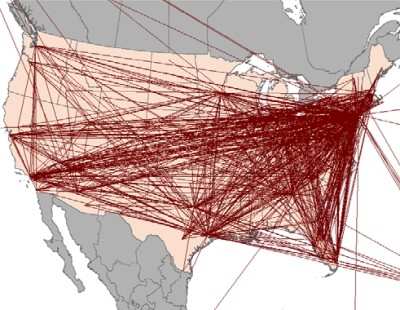Tue, Nov 09, 2010
DOT Inspector General Says A Third Of New York Flights Delayed
Or Cancelled
 The Department of Transportation Office of the Inspector
General has found that as many as one third of flights to and from
the New York region's three primary airports were cancelled or
delayed in 2009, which is still an improvement over the 40 percent
delay or cancellation rate it found in 2007.
The Department of Transportation Office of the Inspector
General has found that as many as one third of flights to and from
the New York region's three primary airports were cancelled or
delayed in 2009, which is still an improvement over the 40 percent
delay or cancellation rate it found in 2007.
In a report to the FAA, the OIG found that there were three
primary reasons for the cancellations and delays: crowded airspace
due to the close proximity and high volume of flight operations of
the three main New York airports; airport capacity constraints; and
continued growth in air traffic during the last 10 years, in part
due to the phase-out of flight limits (caps) from 2000 to 2007.
In a report summary on the DOT website, the OIG said the
re-establishment of those caps at Kennedy in 2008, along with the
implementation of caps for the first time at Newark that same year,
had little effect on overall congestion. " While there is
substantial agreement that New York delays have a nationwide
"ripple effect," the extent and nature of their impact are largely
unknown. FAA's efforts to measure this effect are in the
developmental stage and require additional work to provide a full
understanding of delay propagation," the report said.
The DOT OIG says it made four recommendations to FAA aimed at
reexamining its flight caps, enhancing existing flight data, and
developing a viable methodology for understanding delay propagation
effects. Specifically, the OIG recommended that the FAA:
- Reexamine flight caps at Kennedy, LaGuardia, and Newark
airports, basing the caps on more realistic airport operating
conditions, air carrier scheduling practices, and a goal towards
reducing delays to an acceptable rate. In considering an acceptable
rate and length of delay, FAA should incorporate the views of air
carriers, the airport operator, and passenger groups as well as
lessons learned from other slot-controlled airports.
- Establish a working group of air carriers, academia, and other
aviation research organizations to enhance the understanding of
delay propagation (e.g., develop viable analytic methodologies,
useful database structures, and common terms of reference).
- Enhance existing flight delay data by obtaining aircraft tail
numbers for domestic and international flight operations of U.S.
air carriers in order to better study and manage the propagation
effect of flight delays.
- Complete development of a viable methodology for measuring the
dynamics of flight delays at New York (as well as other U.S.
airports) and their propagation nationwide. This methodology should
include the ability to measure both the amount of delay time being
propagated and the number of subsequent flights being
impacted.

Analysis Of New York Flights Prepared By BTS,
DOT
The Inspector General says that the FAA fully concurred with one
recommendation and partially concurred with three. They have
requested that FAA provide a new written response addressing
specific issues with these three recommendations within 30
days.
More News
With Testing Soon Complete, Launch Preparations Begin in Earnest Sierra Space's Dream Chaser has been put through the wringer at NASA's Glenn Armstrong Test Facility in Ohio, but w>[...]
Takeoff Roll The process whereby an aircraft is aligned with the runway centerline and the aircraft is moving with the intent to take off. For helicopters, this pertains to the act>[...]
“We’re proud of the hard work that went into receiving this validation, and it will be a welcome relief to our customers in the European Union. We couldn’t be mor>[...]
"Aircraft Spruce is pleased to announce the acquisition of the parts distribution operations of Wag-Aero. Wag-Aero was founded in the 1960’s by Dick and Bobbie Wagner in the >[...]
IDENT Feature The special feature in the Air Traffic Control Radar Beacon System (ATCRBS) equipment. It is used to immediately distinguish one displayed beacon target from other be>[...]
 Sierra Space Repositions Dream Chaser for First Mission
Sierra Space Repositions Dream Chaser for First Mission ANN's Daily Aero-Term (05.10.24): Takeoff Roll
ANN's Daily Aero-Term (05.10.24): Takeoff Roll Aero-News: Quote of the Day (05.10.24)
Aero-News: Quote of the Day (05.10.24) Aero-News: Quote of the Day (05.11.24)
Aero-News: Quote of the Day (05.11.24) ANN's Daily Aero-Term (05.11.24): IDENT Feature
ANN's Daily Aero-Term (05.11.24): IDENT Feature




